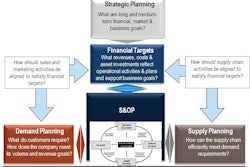Building the case for technology to enable S&OP excellence
Based on a survey of nearly 140 enterprises between June and July 2006, Aberdeen research finds that companies are looking to sales and operations planning (S&OP) processes to help them meet rising customer order fill rate expectations, achieve better return on net assets, protect shrinking profit margins, improve customer retention and better manage extended lead-times due to global sourcing (Figure 1).

Log in to view the full article
Building the case for technology to enable S&OP excellence
Based on a survey of nearly 140 enterprises between June and July 2006, Aberdeen research finds that companies are looking to sales and operations planning (S&OP) processes to help them meet rising customer order fill rate expectations, achieve better return on net assets, protect shrinking profit margins, improve customer retention and better manage extended lead-times due to global sourcing (Figure 1).

However, current S&OP processes are failing to alleviate many of these pressures. While a majority of companies report that S&OP has helped improve forecast accuracy and improved cross-departmental communication, most companies have failed to see improvements in profit-related metrics like gross margin and customer retention (Figure 2). Interviews with executives in both industrial and consumer-oriented business have also confirmed this observation that the companies that have invested in S&OP technologies have made progress in supply/demand matching but inadequate progress towards a profitable S&OP process.

This research indicates that for most companies, traditional S&OP processes do not perform as effectively as they should. In-depth analysis by Aberdeen in 2006 of organizations' S&OP processes finds that companies need to strive toward an Integrated Business Planning process and deploy the supporting technology infrastructure to improve their profit-related metrics.
The key differences of an Integrated Business Planning process compared with a traditional S&OP process are shown in Table 1. Figure 3 shows the elements of an Integrated Business Planning process.


Companies moving to integrated business planning are creating more outward focused processes. "Our company is looking beyond the four walls and extending collaboration to our partners and incorporating requirements of the entire value chain within our S&OP process," says the project manager of a leading networking solutions provider. "Our S&OP process is based on a strong foundation of sound business process as well as a robust enterprise planning platform technology solution."
The aforementioned company had problems matching supply with demand, resulting in inventory surpluses in some instances and order delays in others. To help address these and other problems, the company implemented Collaborative Forecasting and Demand Planning solutions.
Effective forecast quality is fundamental to the quality of the S&OP plan, but that's not enough, as inventory serves as the hedging factor to protect against uncertainty. Some companies are taking planning for inventory to the next level by factoring vendor-managed inventory (VMI) strategies and planning around it in their S&OP process. This allows the consumption of inventory that is not on the balance sheet (e.g. suppliers, manufacturers, partner inventory) with reliable lead-times.
S&OP Technology Adoption
Technology clearly is a vital enabler of integrated business planning. However, according to Aberdeen's 2006 S&OP benchmark results, 61 percent of companies lack enterprise automation for their S&OP processes. Only 16 percent of firms are using Best in Class S&OP solutions for enabling their S&OP process. This lack of technology enablement is making companies rely on traditional spreadsheet based approaches for their S&OP process, which results in reduced corporate performance and being unable to reach the potential of the benefits that S&OP can offer.
As shown in Figure 4, 41 percent of the companies surveyed reported that they are using spreadsheets for their S&OP solution. Nearly 30 percent of these companies have enterprise resource planning (ERP) solutions that are capable of doing S&OP demand and supply planning, but these companies have chosen to supplement with spreadsheets for their S&OP process. The main reasons cited by these companies are that their users are more comfortable using spreadsheets and that the ERP technology solution was too complex for them or does not provide adequate capabilities.
Although it is convenient to use spreadsheets, this strategy lends itself to multiple versions of the data and is rarely accurate or effective over the long term. This approach also does not lend itself to executive level inputs.
The vice president of strategic business processes at a leading food processing company talks about their technology architecture prior to implementing a leading S&OP specialist solution. "Our company is 88 years old and we ran our operations for 20 years using spreadsheets. Obviously we were able to sustain our business that way. Key issues that we faced with spreadsheets were:
- The amount of variables being able to take into consideration in the spreadsheet. We could only model a limited number of decision points within our spreadsheet solution. When changes of sales forecast happened, we paid the price on the inventory stock levels, increased production costs, and increased expediting costs.
- Also as global market became more complicated, we could not sustain the spreadsheet based process.
- Another issue was that there were a few gurus who knew how to handle the very complex spreadsheets and knowledge sharing was a problem.
Once technology solutions were put in place these problems got resolved. For example, overtime was reduced from 23 to 10 percent."

Why is Technology Important for Enabling Integrated Business Planning?
Aberdeen research finds that 78 percent of companies say that technology is either critical or very important for their S&OP process. There are several reasons why technology plays a critical role in helping companies achieve better S&OP results and move toward an integrated business planning process.
- Data management. Today's organizations often have myriad sources of data colored by many different perspectives — sales, customers, marketing, suppliers, manufacturing, logistics, and finance. Because this data tends to be present within disparate systems and are complex in nature, data management and integration capabilities are needed to ensure that data inputs are timely, complete, and are incorporated into the S&OP plan in an accurate manner (e.g., adjustments are made for differing units of measure, customer and item master inconsistencies, variable time horizons, and so on).
- Multi-dimensional goals and views. S&OP places the spotlight on different goals — revenues, margins, working capital, forecast accuracy, supply/demand match. Organizations need to look at the data in different ways in terms of aggregation as well as units. For instance, finance and sales typically look at the product family level and in dollar unit sales and manufacturing looks at unit level and end item SKU level. Creating multi-dimensional views of the plan that also support what-if analysis is something beyond the capacity of a spreadsheet process.
- More dynamic business processes. Faster and more frequent S&OP cycles are required to keep pace with shorter product life cycles, compressed order lead time requirements, and more dynamic demand. Technology enables automating these processes as well as decreases the times that S&OP planners spend on manual operations versus doing more productive work. More importantly technology enables the ability to rapidly react when real-life scenarios unfold in real-time like supply shortages, plant breakdowns, etc.
- More decision parameters. Involved in coming with the Integrated Business Plan which cannot be tackled by manual technology. Some critical decision parameters are overall margin, product family level margins, budget (financial plan), inventory, supply capacity, demand accuracy, service level requirements, etc. These decision parameters are often multi-dimensional and often involve attributes that may be different at different levels of aggregation, for example, demand accuracy at a product family level may be measured differently than the demand accuracy at a SKU level. These require support from technology to not only model but also to manage and monitor.
How to Make Your S&OP Process More Successful
- Establish an inter-disciplinary marketing, sales, finance and operations team to manage the process and support it with the right metrics. Increase collaboration with key customers to drive to a collaborative single demand forecast. Finance teams need to play a more important role in Integrated Business Planning processes.
- Integrate the sales revenue planning process with the demand planning process — integrate the customer, supplier and internal systems into the process.
- Move toward supply and demand shaping. Look into incentives, promotions and other causal events to shape demand. Look into profit optimized sourcing of supply and optimal inventory allocation to shape the supply.
- Set up financial metrics like working capital, gross margin in addition to the operational metrics. Build closed loop analytics and performance management systems for top management.
- Invest in technology enablers that allow the institutionalization of the S&OP process with application infrastructure, security, user roles, and workflows in an enterprise environment. ERP systems and Best in Class supply chain vendors should be considered by these companies.
- Explore specialized S&OP players which bring years of domain expertise, low cost and ability to present a quick ROI. These tools often work on top of excel spreadsheets and help change the mindset of users from reactive "planning" to an Integrated Business Planning mindset.
Read more recommendations in the " Technology Strategies for Integrated Business Planning Benchmark Report " published by AberdeenGroup, which is available to the readers of the article for free.
About the Author: Nari Viswanathan serves as Research director in Aberdeen Group's Supply Chain & Logistics Practice. He specializes in order-to-delivery and S&OP processes. His research investigates the business strategies and technologies that drive cost reductions and productivity improvements for order-to-delivery processes within different industries. Viswanathan's business process and technology expertise includes demand management, manufacturing management, and demand fulfillment. He holds a masters degree in manufacturing engineering from the University of Wisconsin-Madison and a bachelor's degree in Mechanical Engineering from the Indian Institute of Technology, Madras.









